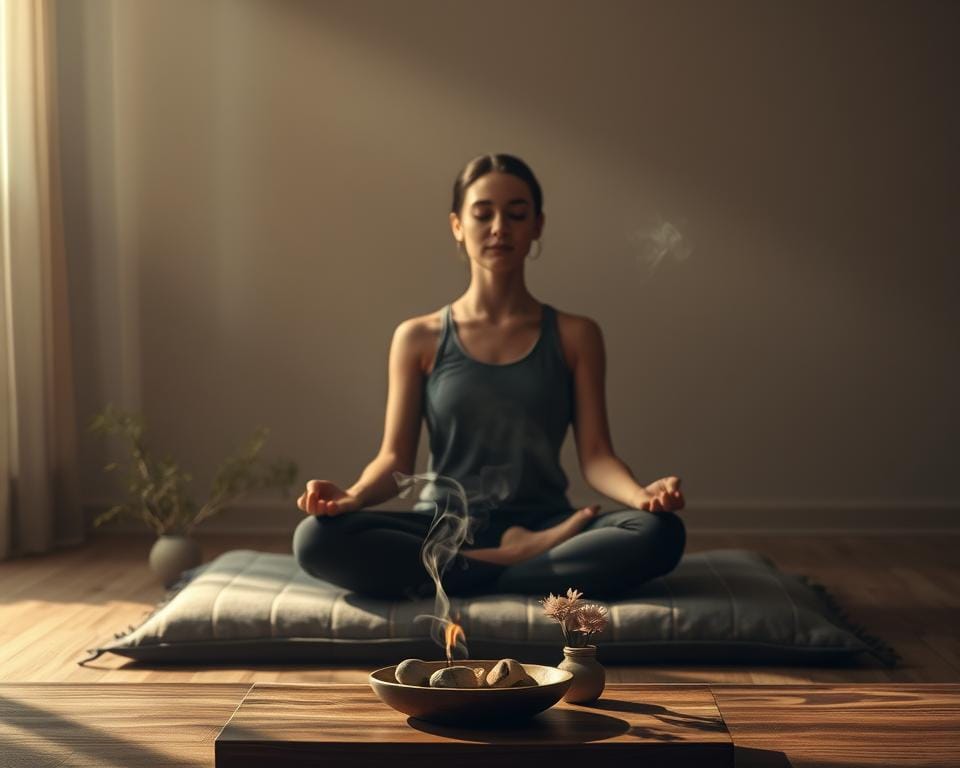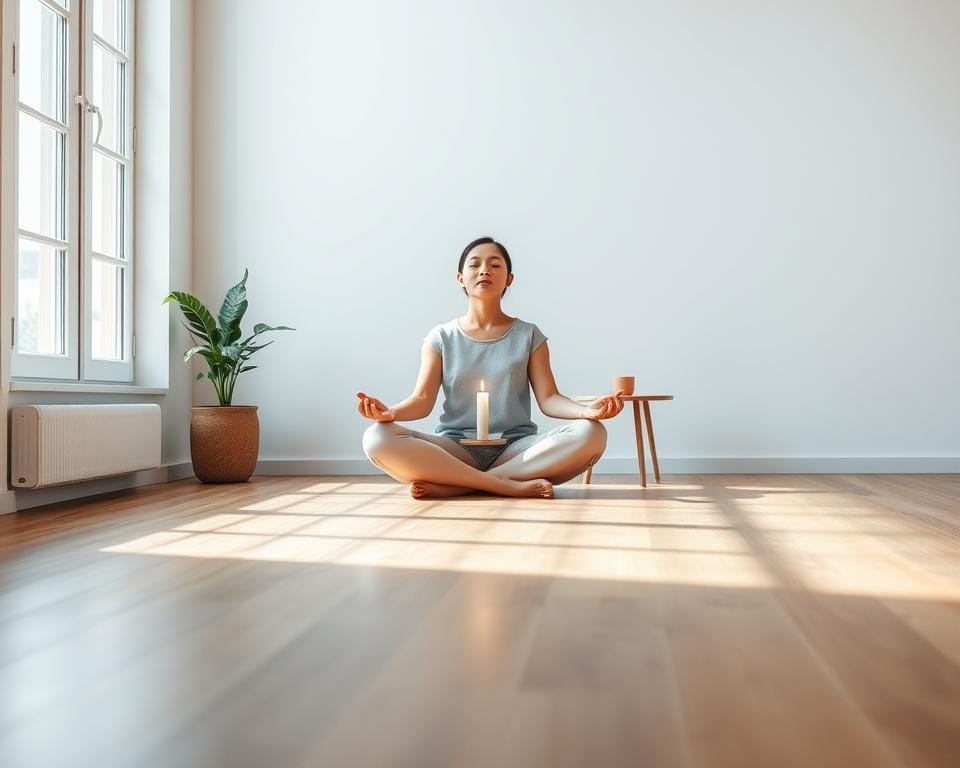Imagine sipping your morning tea while actually tasting it, rather than mentally replaying yesterday’s meeting. What if pausing to notice the rhythm of your breath could soften the edges of a chaotic day? This isn’t about carving out extra time – it’s about reshaping how we experience the moments we already have.
Mindfulness isn’t reserved for meditation cushions. It’s the art of showing up fully – whether you’re washing dishes or walking to the shop. I’ve found that weaving awareness into ordinary routines helps dissolve that autopilot feeling we all battle. You start noticing how sunlight patterns shift through your kitchen window, or how your shoulders relax when you exhale properly.
Our brains love clinging to past regrets or future worries. Yet life unfolds now, in the steam rising from your mug or the way rain taps against the window. Small acts of presence build resilience against modern chaos. They help us respond to challenges instead of reacting blindly.
Key Takeaways
- Mindfulness transforms routine tasks into opportunities for calm
- Conscious awareness requires no special equipment or extra time
- Noticing sensory details anchors us in the present moment
- Brief pauses throughout the day cultivate mental clarity
- Simple practices help break cycles of stress and autopilot living
Discovering Easy Mindful Habits to Start
That first sip of coffee? I used to gulp it while scrolling through emails. Now, I let the warmth linger on my tongue for three breaths before reaching for my phone. This tiny shift became my gateway to building awareness without overhauling my schedule.
Small Changes, Big Shifts
Start with one change in your existing routine. Mine was pausing to taste my morning brew properly. Within weeks, this practice naturally expanded to noticing birdsong during school runs. Research shows it takes 18-254 days to form habits – be kind if your journey feels slow.
Practical Anchors for Busy Days
I set phone reminders labelled “Breathe” that pop up randomly. When they do, I take three deep breaths while observing:
- The texture of my clothes against my skin
- Sounds filtering through the window
- Flavours lingering from my last meal
These 90-second resets stopped me from yelling at rush hour traffic last Thursday. The key? Pair new practices with existing triggers – like checking the time or waiting for the kettle to boil. What daily moments could become your awareness anchors?
The Power of Mindfulness for Everyday Calm
Last week, I noticed my shoulders were practically hugging my ears during a work call. That physical tension sparked a realisation: our bodies often shout what our mind whispers. Neuroscience confirms this – studies show regular mindfulness practice can shrink the brain’s stress centres while boosting areas linked to emotional regulation.

Reducing anxiety through intentional practice
When deadlines loom, I use this simple reset: close my eyes and name three sounds I hear. It creates space between stimulus and reaction – like installing a mental pause button. Research suggests even 10 minutes of daily meditation reduces anxiety symptoms by 39% in eight weeks.
Body scans became my secret weapon. Lying down, I mentally trace from toes to scalp, noting sensations without judgement. Last month, this helped me spot tension headaches brewing before they escalated. It’s about catching stress early, like seeing storm clouds before the downpour.
| Technique | Impact on Anxiety | Duration of Effect |
|---|---|---|
| Mindfulness | Reduces rumination | Long-term |
| Deep breathing | Lowers heart rate | Immediate |
| Exercise | Releases endorphins | 2-4 hours |
What surprised me most? How mindfulness helps distinguish real problems from mental noise. That “urgent” email? Often just loud, not important. By training my focus, I’ve learned to respond to challenges rather than drown in them.
For newcomers: start with 60-second check-ins. Notice your breath rhythm while waiting for the Tube. Taste your biscuit properly during tea breaks. These micro-moments build mental muscle to handle life’s curveballs.
Simple Mindful Breathing and Movement Techniques
Last Tuesday, while walking my spaniel through muddy fields, I realised my breaths were syncing with her pawsteps. This accidental rhythm became a revelation: combining movement with conscious breath transforms ordinary activities into grounding rituals.
Using breath and gentle movement to restore balance
Try this during your next cuppa: inhale deeply through your nose, feeling your collarbones rise. Exhale slowly, imagining tension melting like butter on warm toast. Proper breathing engages your diaphragm – that dome-shaped muscle beneath your ribs – creating space for calm.
When stress strikes, I practise mindful movement with simple stretches. Reach upwards while breathing in, then fold forward as you exhale. Repeat three times. It’s like giving your body a mini-reset button. For structured sequences, this beginner’s yoga guide offers brilliant starter poses.
Mindful walking and body scanning for clarity
Turn your next park stroll into moving meditation. Notice how your weight shifts from heel to toe with each step. Count twenty paces, then pause to name three sensations – maybe breeze on your neck or birds chattering overhead.
Body scans work wonders before bed. Lie down and mentally explore from toes to scalp. Last week, I discovered jaw tension I’d ignored for days. Breathe into tight spots – they often soften like knotted thread meeting patience.
| Technique | Primary Focus | Ideal Duration |
|---|---|---|
| Diaphragmatic breathing | Full torso engagement | 3-5 minutes |
| Walking meditation | Footstep awareness | 10+ minutes |
| Body scanning | Tension detection | 7-15 minutes |
These practices needn’t be perfect – my first attempts felt clumsier than a toddler’s pirouette. What matters? Showing up. Your body will thank you with deeper calm and sharper focus.
Mindful Eating and Its Impact on Wellbeing
Last Sunday, I rediscovered the crackle of a freshly baked sourdough crust as I broke into my lunch. That satisfying moment became my gateway to understanding how we often miss life’s simplest pleasures between bites. Eating with full attention isn’t about restrictive diets – it’s about savouring the journey from farm to fork.

Transforming mealtimes into moments of awareness
Try this tomorrow: before lifting your fork, pause to notice your meal’s colours and textures. I’ve found this way of engaging my senses helps me eat slower and digest better. Research shows chewing thoroughly allows your body to register fullness signals properly – something I wish I’d known during my crisp-devouring student days.
Create a phone-free zone during meals. Last month, I started leaving my mobile in another room – turns out Instagram reels taste terrible with roasted veg. This simple change helped me:
- Notice subtle flavours in everyday dishes
- Recognise when I’m genuinely hungry versus bored
- Appreciate the effort behind each ingredient
When eating out, I practise the “first bite ritual”. Close your eyes and focus solely on that initial taste explosion. It’s like giving your meal a proper introduction rather than shovelling fuel into your face hole. This awareness helps me make better food choices without feeling deprived.
Remember: there’s no “perfect” time to start. My first attempts felt as awkward as using chopsticks for spaghetti. But even rushed sandwiches deserve attention. Next time you snack, try naming three textures you experience. Those crisps? Maybe salty, crunchy, and… surprisingly poetic when you’re fully present.
Integrating Mindfulness into a Busy Lifestyle
Last Thursday, I transformed my delayed train commute into a practice session. Instead of refreshing departure boards, I counted passing platform lights while syncing my breath. This unexpected routine became my blueprint for weaving awareness into packed days.
Practical tips for incorporating mindfulness in daily routines
Single-tasking revolutionised my work life. I now close all browser tabs except my current project. Turns out, focusing on one email at a time actually speeds up my reply rate. Try these micro-practices:
- Set phone to grayscale mode during family meals
- Feel keyboard vibrations while typing meeting notes
- Name three colours in your surroundings during loo breaks
Creating calm amidst modern distractions
I’ve started treating notifications like uninvited guests – they wait outside during activities that matter. My post-lockdown hack? Charging devices in the hallway overnight. For commuters: try mindful driving by noticing gear changes and traffic light sequences.
Five-minute resets work wonders. Yesterday, I practised yoga poses while my soup reheated. The key? Pair practices with existing parts of your day. That tedious queue at Pret? Perfect for shoulder rolls and breath counting.
Conclusion
This morning, I burnt my toast but found myself laughing instead of stressing. That’s the magic of weaving mindfulness into daily life – it turns mishaps into moments of connection. What began as scattered practices has grown into a lens that reshapes how I experience everything from work calls to washing-up.
Progress isn’t about perfect focus. It’s showing up – even if that means restarting your breath count twelve times during a Tube delay. Try choosing one daily trigger: maybe your first cuppa or checking emails. Use it to anchor three conscious breaths.
The ripple effects surprise me most. When I prioritise presence, I listen better to colleagues and spot my toddler’s unspoken worries. Studies confirm this – regular practice literally rewires how we process stress and relate to others.
Start small. Forgot your meditation app today? Notice the weight of your mug instead. Those micro-moments build mental muscle. My burnt toast taught me more about compassion than any seminar – sometimes, life’s best lessons come charred.
Where will your mindfulness journey begin? Perhaps with your next biscuit’s crunch or a colleague’s sigh. The present moment waits patiently, always ready to welcome you back.

